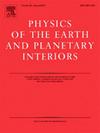A potential deep geothermal reservoir in eastern Ladakh as inferred from the upper crustal geoelectric structure of the region
IF 1.9
3区 地球科学
Q2 GEOCHEMISTRY & GEOPHYSICS
引用次数: 0
Abstract
The Ladakh Himalaya is a repository of the evolutionary history of the India-Eurasia convergent plate margin. We present the results of a magnetotelluric (MT) study carried out in Eastern Ladakh along a 40-km-long profile traversing across various tectonic domains of this plate margin. We modeled the MT dataset by two-dimensional (2-D) and three-dimensional (3-D) inversion algorithms. The upper crustal geoelectric model obtained by 2-D inversion of distortion corrected and decomposed data of 18 sites shows an excellent match with the surface geology. In this model, the Indus Suture Zone (ISZ) appears as a steeply dipping contact and the Ladakh batholith is about 10 to 12 km thick. The model yields a prominent electrical conductor of ∼6 km diameter at 4 km depth beneath the Tso Morari Crystallines with an offshoot of a small conductor that rises upward along the ISZ. The geoelectrical model obtained by 3-D inversion is broadly consistent with the 2-D model but also reveals off-profile features and a connectivity of the shallow conductors with a widespread conductive zone at deeper level of the upper crust. In view of the presence of Puga and Chumathang hot springs towards west and Demchok hot springs towards east of our study region, we infer these conductors to be representing a potential major geothermal reservoir system connected to the widespread deeper conductive zone of partial melts, which extends from the southern Tibet to the eastern Ladakh region.

从拉达克地区上地壳地电结构推断出该地区东部潜在的深层地热储层
拉达克喜马拉雅山是印度-欧亚交汇板块边缘演化历史的宝库。我们介绍了在拉达克东部沿 40 公里长的剖面横穿该板块边缘不同构造域进行的磁法(MT)研究的结果。我们采用二维(2-D)和三维(3-D)反演算法对 MT 数据集进行建模。通过对 18 个站点的畸变校正和分解数据进行二维反演得到的上地壳地电模型与地表地质非常吻合。在该模型中,印度河断裂带(ISZ)呈现为陡峭的倾斜接触,拉达克岩床厚约 10 至 12 千米。根据该模型,在措莫拉里(Tso Morari)结晶下 4 千米深处有一个直径为 6 千米的突出导体,其分支是沿印度河断裂带向上延伸的一个小导体。通过三维反演获得的地质电学模型与二维模型基本一致,但也揭示了一些非剖面特征,以及浅层导体与上地壳深层广泛导电带之间的联系。鉴于研究区域西面有普嘎温泉和楚玛塘温泉,东面有德木措温泉,我们推断这些导体代表了一个潜在的主要地热储层系统,与从西藏南部延伸到拉达克地区东部的广泛深层部分熔体导电带相连。
本文章由计算机程序翻译,如有差异,请以英文原文为准。
求助全文
约1分钟内获得全文
求助全文
来源期刊

Physics of the Earth and Planetary Interiors
地学天文-地球化学与地球物理
CiteScore
5.00
自引率
4.30%
发文量
78
审稿时长
18.5 weeks
期刊介绍:
Launched in 1968 to fill the need for an international journal in the field of planetary physics, geodesy and geophysics, Physics of the Earth and Planetary Interiors has now grown to become important reading matter for all geophysicists. It is the only journal to be entirely devoted to the physical and chemical processes of planetary interiors.
Original research papers, review articles, short communications and book reviews are all published on a regular basis; and from time to time special issues of the journal are devoted to the publication of the proceedings of symposia and congresses which the editors feel will be of particular interest to the reader.
 求助内容:
求助内容: 应助结果提醒方式:
应助结果提醒方式:


